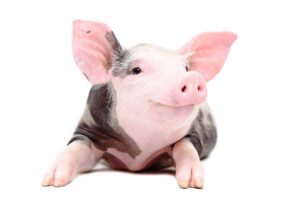“Diarrhoea in pigs? 100 years ago, crushed clay tile was fed to pigs in the villages…”

Pig feeding in 2024
Pig breeding, especially its intensification, genetic advances, nutritional and environmental requirements pose a major challenge to breeders. Adequate pig nutrition influences most parameters of breeding profitability, such as feed consumption per kilogram of body weight gain, animal mortality, fattening length or sow fertility.
Modern pig breeds have high nutritional requirements, so their feeds contain high levels of protein and energy, resulting in various health problems (intestinal failure, diarrhoea, high levels of ammonia in the air or wet bedding). This is why zinc oxide was widely used for many years in the pig production sector to counteract the above phenomena and to reduce diarrhoea.
Unfortunately, the environmental impact of zinc oxide is not neutral. As a result, there are increasing restrictions on the use of zinc oxide in pig farming – and there has been a need to use products with analogous effects that do not have a detrimental impact on the environment.
Mega Stopper as a natural alternative to zinc oxide
The Polish company, Polfeed, which is the leading producer of dried fruit in Europe, has developed an innovative product based on natural raw materials that is as effective as zinc oxide – Mega Stopper. It is a formulation based on aluminosilicates and carbon, which stabilises and thickens the digestive contents.
What was it like 100 years ago?
In the past, zinc oxide or other synthetic products were not used in pig farming. So how did they deal with poisoning in livestock in the villages? – That’s what makes it very interesting,” says Marek Kasprzyk, animal technician, animal nutritionist and co-founder of Polfeed.
– My grandmother in the 1930s already knew that poisoned animals should be given… crushed red roofing tile. I know, it sounds absurd.However, there is an underlying folk wisdom in this phenomenon. Back then, roof tiles were created from clay, among other materials. It was this clay that proved to be the cure for all kinds of intestinal problems in animals. Our grandmothers knew this… from their grandmothers. This knowledge has been passed down for generations. The people who were involved in breeding were observing the animals. The animals themselves (in the case of poisoning) instinctively sought out soil containing clay and ate it. It’s an instinct. – explains Polfeed co-founder Marek Kasprzyk.
Nature should be the chief food technologist
As animal nutritionist Marek Kasprzyk adds: – We saw it first-hand when we dumped the wet silt (coal-aluminosilicate) in front of our production facility. Within a few hours, wild birds from all over the region had flocked in and started eating our raw material. Nature is amazing. – Our product is based precisely on ‘knowledge taken straight from nature’ and ‘instinctive animal behaviour’. It is nature that is our main food technologist. – Kasprzyk laughs. – This is how our product, Mega Stopper, was developed…
Benefits of Mega Stopper: effectively binds toxins, does not penetrate the blood, improves faecal structure…
The proportion of kaolinite to carbon provides a unique microporous structure, so that our product effectively binds the various types of toxins (mycotoxins and endotoxins) found in the animals’ digestive tract. It does not penetrate the blood unlike antibiotics and acts like a sponge (cleans the digestive tract) with little sorption of nutrients, vitamins and minerals from the feed.
According to studies and observations on pig farms, the regular use of Mega Stopper at a rate of 0.1-0.5 per cent in feed mixes for weaned piglets reduces the level of ammonia in the air, resulting in better health and condition of the animals and thus reducing the unpleasant odour in the facility as well as in the immediate surroundings.
After using Mega Stopper, not only was an improvement in faecal structure observed (from good to very good), but also a reduction in the frequency of diarrhoea. Further advantages of our product also include lower level of falls among pigs, higher weight gains and better feed utilisation. For all breeders willing to test a natural alternative to zinc oxide, we are offering free samples of Mega Stopper in order to see how effective nature is in the fight against nutritional problems in animals.
Do you have questions?
Feel free to contact us! Our Polfeed Quality and Sales Specialist, Tomek Merta is already waiting! >>tomasz.merta@polfeed.pl
| age group/body weight | dosage of Mega Stopper per tonne of feed |
|---|---|
| piglets 1-7 kg | 3 kg/tonne |
| piglets 7-15 kg | 3÷5 kg/tonne |
| piglets 15-30 kg | 3 kg/tonne |
| fattening pigs 30-120 kg | 1÷2 kg/tonne |
| sows | 1÷2 kg/tonne |
| body weight | Mega Stopper dosage* | average Mega Stopper consumption per unit/body weight |
|---|---|---|
| 1-30 kg (piglets, weaners) | 3÷4 kg/tonne of feed (from 1-30 kg pig body weight) | 0,14 kg |
| 30-120 kg (fattening pigs) | 1÷2 kg/tonne of feed (from 30-120 kg pig body weight) | 0,35 kg |
| 1-120 kg pig weight per head | 0,49 kg | |
| sows | 1÷2 kg/tonne of feed | 2 kg per head per year |
*In cases of acute inflammation of the digestive tract, up to 6 kg per tonne of feed can be used without the risk of complications.
21.10.2024